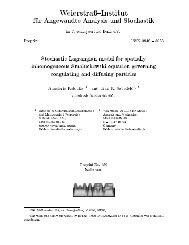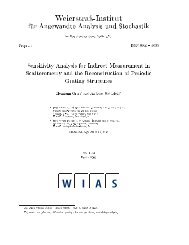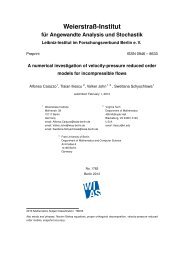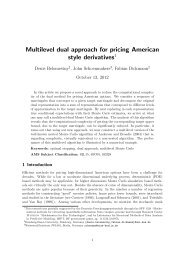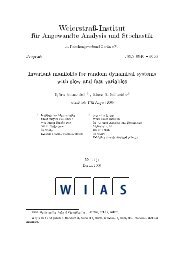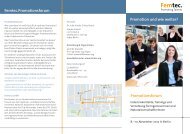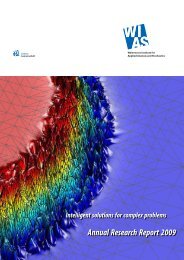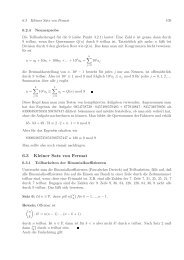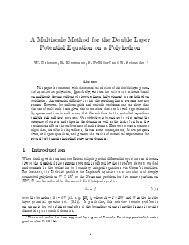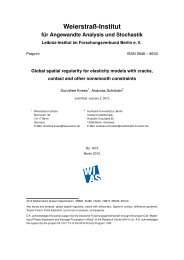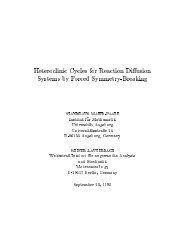PDF (5143 kByte) - WIAS
PDF (5143 kByte) - WIAS
PDF (5143 kByte) - WIAS
You also want an ePaper? Increase the reach of your titles
YUMPU automatically turns print PDFs into web optimized ePapers that Google loves.
ABSTRACT. We introduce an algorithm for diffusion weighted magnetic resonance imaging data<br />
enhancement based on structural adaptive smoothing in both space and diffusion direction. The<br />
method, called POAS, does not refer to a specific model for the data, like the diffusion tensor or<br />
higher order models. It works by embedding the measurement space into a space with defined<br />
metric and group operations, in this case the Lie group of three-dimensional Euclidean motion<br />
SE(3). Subsequently, pairwise comparisons of the values of the diffusion weighted signal are<br />
used for adaptation. The position-orientation adaptive smoothing preserves the edges of the<br />
observed fine and anisotropic structures. The POAS-algorithm is designed to reduce noise<br />
directly in the diffusion weighted images and consequently also to reduce bias and variability of<br />
quantities derived from the data for specific models. We evaluate the algorithm on simulated and<br />
experimental data and demonstrate that it can be used to reduce the number of applied diffusion<br />
gradients and hence acquisition time while achieving similar quality of data, or to improve the<br />
quality of data acquired in a clinically feasible scan time setting.<br />
1. INTRODUCTION<br />
Diffusion weighted magnetic resonance imaging (dMRI) has evolved into a versatile tool for<br />
in-vivo examination of micro-structure in the human brain [Le Bihan, 2003], spinal cord [Clark<br />
et al., 1999], or muscle tissue [Sinha et al., 2006]. The data is measured using the pulsed<br />
gradient spin echo sequence [PGSE, Stejskal and Tanner, 1965] through application of diffusion<br />
magnetic field gradients in different directions. The technique is based on the fact that nuclear<br />
magnetic resonance is sensitive to the diffusion of molecules, usually water. Each applied<br />
magnetic field gradient yields a diffusion weighted image which, together with the non-diffusion<br />
weighted image, reveals information about the average displacement of hydrogen protons in the<br />
corresponding direction at each voxel.<br />
In the past two decades the development of diffusion tensor imaging (DTI) made dMRI more feasible<br />
for a wider range of clinical and neuroscience applications (see Mori [2007] and Johansen-<br />
Berg and Behrens [2009] for an introduction). In order to characterize the data by a diffusion<br />
tensor at least six gradient directions have to be measured. However, the diffusion tensor model<br />
provides only an approximation for the more realistic case of inhomogeneous and restricted diffusion,<br />
spurring recent interest in models beyond DTI [Assemlal et al., 2011]. Most of the methods<br />
developed to overcome the limitations of DTI require a larger number of diffusion weighted<br />
gradients to be applied during measurement and hence a longer acquisition time.<br />
Like all other imaging modalities dMRI suffers from significant noise which may render subsequent<br />
analysis or medical decisions more difficult. For DTI it has been shown that noise induces<br />
a systematically biased assessment of features, like the fractional anisotropy (FA), which are<br />
based on the ordered eigenvalues of the estimated diffusion tensor [Pierpaoli and Basser, 1996,<br />
Basser and Pajevic, 2000]. Jones and Basser [2004] showed that noise creates artifacts for<br />
dMRI data in general. Last but not least, increasing the spatial resolution inherently decreases<br />
the signal-to-noise ratio (SNR). Attempts to achieve higher image resolution collide with the<br />
deterioration of the acquired images. Noise reduction is therefore essential.<br />
Besides simple isotropic smoothing, which potentially blurs fine structures, more sophisticated<br />
methods for noise reduction have been developed, such as the Perona-Malik filter [Perona<br />
and Malik, 1990, Parker et al., 2000], non-linear diffusion approaches [Weickert, 1998, Ding<br />
et al., 2005, Duits and Franken, 2011], or the Propagation-Separation approach [Polzehl and<br />
Spokoiny, 2006, Tabelow et al., 2008]. Other attempts combine wavelet filtering with subsequent<br />
1




